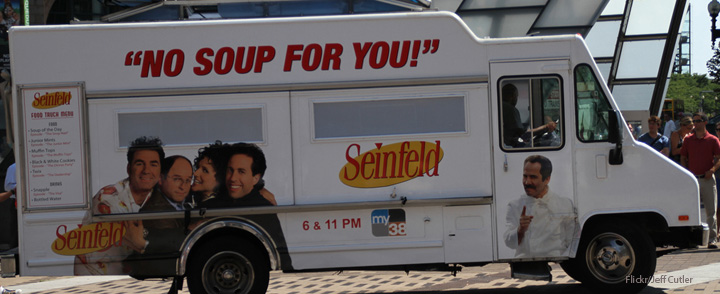Twenty-five years ago this month, The Seinfeld Chronicles made its debut and four borderline sociopaths living in existential desperation made their way into our lives for the next nine years.
The “show about nothing,” which NBC execs initially didn’t believe would click with audiences while calling its premise “too New York, too Jewish,” was given just four episodes to justify its existence before being taken off the air for a year. Had it not been for the tireless efforts of one executive who saw the show’s potential, the series would have never made it past the pilot, in which we find Jerry and George having an inane argument about placement of shirt buttons in a bustling coffee shop. It was fair to call the initial four episodes a work in progress.
Oh, but did it ever make a glorious return, going on to redefine the sitcom genre and transcend television as we know it, celebrating the excruciating minutiae and annoyingness of everyday existence, whether it be waiting for a table at a Chinese restaurant or being annoyed with people who double dip, people who eat their peas one at a time or being annoyed at, well, just about anything. Seinfeld was a massive success, serving as appointment viewing for more than 76 million Americans at the height of its popularity in the ’90s, and becoming one of the most successful shows in U.S. television history, kvetching and kvelling its way to the top of Arthur Nielsen Media Research Ratings every year from 1994 to 1998.
Seinfeld, which still airs in syndication on more than 250 stations across the country on prime real estate, provided laser-sharp observations about our culture while dealing with an array of Jewish issues, whether that be difficulties finding a mohel, coping with blabby rabbis, falling for women for their “shiksappeal,” being mildly outraged with people who convert to Judaism for the wrong reasons or shopping for the perfect chocolate babka. Seinfeld was a sitcom like no other, in which the characters never learned a lesson in morality and the error of their ways or subsequently grew more mature as a result of their actions. Most episodes painted two bleak worldviews: Most people are inherently bad (and not very bright), or caring about other people’s feelings is absurd (and not very practical, either).
Much of the show’s observational and innocuous brand of humor and coffee-shop banter was based on surviving daily in a world of small but humiliating situations, and discussing them all with your self-pitying and neurotic friends afterward — a group of people sitting around and doing, famously, nothing. But besides the phrases it gave us — “sponge-worthy,” “shrinkage” and “yada yada,” its quotability and its perpetuation in syndicated reruns, the themes Seinfeld was built around are so very universal.
Who, at one point, hasn’t thought about arguing with a clerk after getting wrong change, or confronting someone for taking credit for something they didn’t do? This stuff isn’t just shtick—it’s a masterful rendering of the absurd and the all-too-true.
Our society’s appreciation for the show has even spawned various “Seinfeld to go” Twitter accounts such as @Seinfeldtoday and @Seinfeld2000, which imagine what the show would be like if it were still on the air, perfectly capture the mocking “no hugging, no learning” philosophy that formed Seinfeld’s core in 140 characters or less while racking up a whopping 1.2 million followers.
Twenty-five years later, it is not hyperbolic to say that Seinfeld is one of the most culturally important comedic works of its generation, painting an honest picture of the inextricable frustrations of modern life. The show’s work is still felt in more contemporary shows like How I Met Your Mother, Arrested Development and It’s Always Sunny in Philadelphia (and previously, The Office). It’s best legacy, however, is Seinfeld writer Larry David’s cringe-inducing HBO comedy Curb Your Enthusiasm, which takes the everyday comic absurdity and selfishness of Seinfeld to a new level as Larry David fumbles through his vain life offending absolutely everyone.
The show that was supposedly about “nothing” was, in fact, about everything. “Look around, life is full of characters,” its creators seemed to be telling us. “There are more Georges, Kramers, Elaines and Newmans around you than you know, and the world itself is much, much stranger than you give it credit for.”
